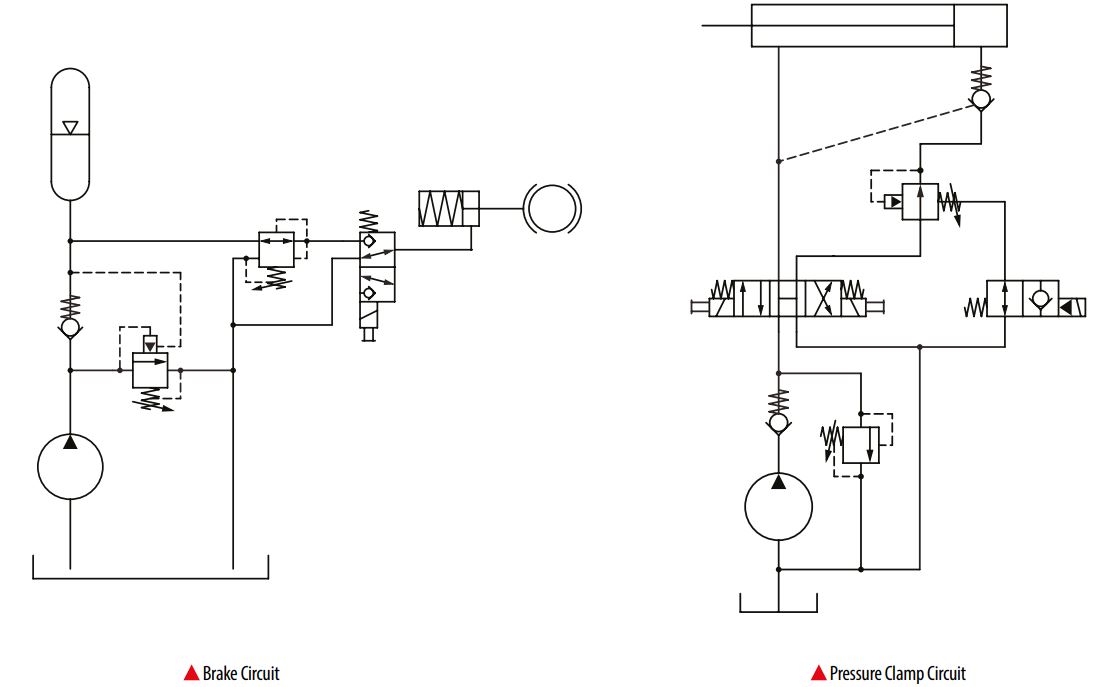
Pressure-reducing valves
Pressure-reducing valves limit pressure in one portion of a circuit without affecting system pressure. With flow ratings up to 300 l/min [80 US gal/min] and pressure ratings up to 350 bar [5,075 psi], they are available in direct-acting or pilot-operated types for pressure reducing/relieving or reducing alone.
Features and benefits
- Provide pressure control in systems requiring two or more different pressure settings
- Wide range of valves available
- All operating parts made of hardened and ground materials for maximum durability and leak protection
- Enhanced corrosion protection
- Can be supplied with zinc plating and anodized aluminum manifolds for additional corrosion resistance
- Direct-acting valves provide fast response and are economical solution for low flow applications such as hydraulic brake or motor shift
- Pilot-operated valves provide smooth, stable response for high pressure applications, along with precise pressure control with varying flow rates
Applications
- Agriculture
- Construction
- Cranes and material handling
- Forestry
- Lawn and turf
- Road building
Basic operation
Pressure-reducing valves are normally-open, pressure-limiting devices. They limit one part of a circuit to a pre-determined setting, while allowing the inlet pressure to rise to full system pressure, if necessary. They come in two forms: direct-acting or pilot-operated. Both types have the option of an integrated pressure relief valve, which limits the regulated pressure in the case of external forces.
Direct-acting spool type with relief
The direct-acting pressure reducing valve is normally open from port 2 to 1, with port 3 connected to tank. As the pressure at the regulated port 1 increases to the valve setting, the spool moves back against the spring and restricts the flow between port 2 and 1 to maintain the regulated pressure setting. This limits the pressure in port 1, while pressure in port 2 will continue to rise. If an external force creates excessive pressure in the regulated port 1, the spool will move further back and open port 1 to port 3, working as a relief valve.

Pilot-operated spool type with relief
The pilot-operated pressure-reducing valve is normally open from port 2 to 1, with port 3 connected to tank. As the pressure on the regulated port 1 increases to the valve setting, the pilot section will open and allow the main spool to shift and restrict flow from port 2 to 1. If the pressure in port 1 continues to rise, the main spool will move further back, blocking the line between port 2 and 1. This limits the pressure in port 1, while pressure in port 2 will continue to rise. If an external force causes the pressure in port 1 to rise above the valve setting, the main spool will shift further and open port 1 to tank port 3, acting as a relief.

Direct-acting spool type without relief
The direct-acting pressure-reducing valve without relief is normally open from port 2 to 1, with port 3 connected as a drain port only to tank. As the pressure at the regulated port 1 increases to the valve setting, the spool moves back against the spring and restricts the flow between port 2 and 1 to maintain the regulated pressure setting. This limits the pressure in port 1, while pressure in port 2 will continue to rise.

Pilot-operated spool type without relief
The pilot operated pressure reducing valve without relief is normally open from port 2 to 1, with port 3 connected to tank. As the pressure on the regulated port 1 increases to the valve setting, the pilot section will open and allow the main spool to shift and restrict flow from port 2 to 1. If the pressure in port 1 continues to rise, the main spool will move further back, blocking the line between port 2 and 1. This limits the pressure in port 1, while pressure in port 2 will continue to rise.

Typical application diagrams

Pressure-reducing valve comparison
|
Characteristic/type |
Direct-acting reducing |
Direct acting reducing/relieving |
Pilot-operated reducing |
Pilot-operated reducing/relieving |
| Dirt tolerant | - | - | - | - |
| Fast acting | + | + | - | - |
| Flow | - | - | + | + |
| Pressure | - | - | + | + |
| Stable | - | - | + | + |
| Relative Price [1 lowest] | 1 | 1 | 2 | 2 |
